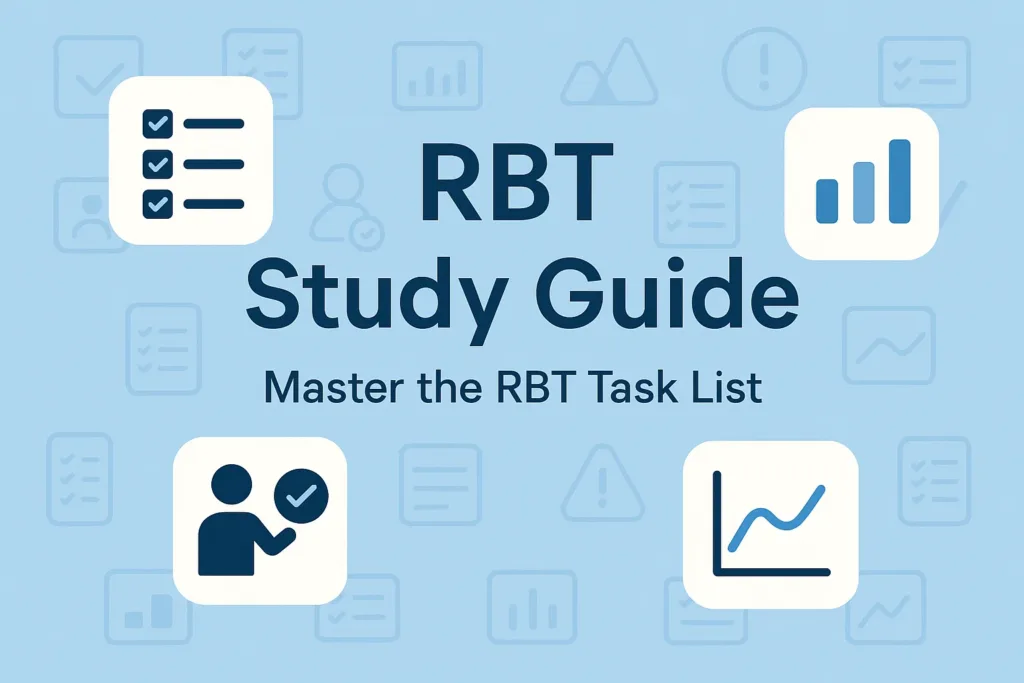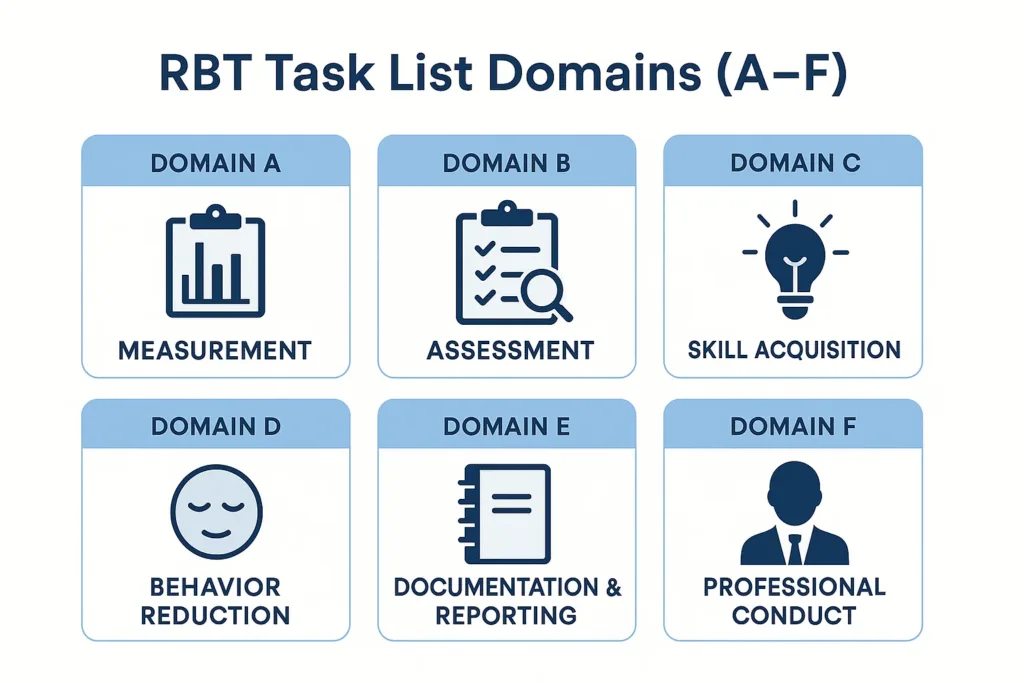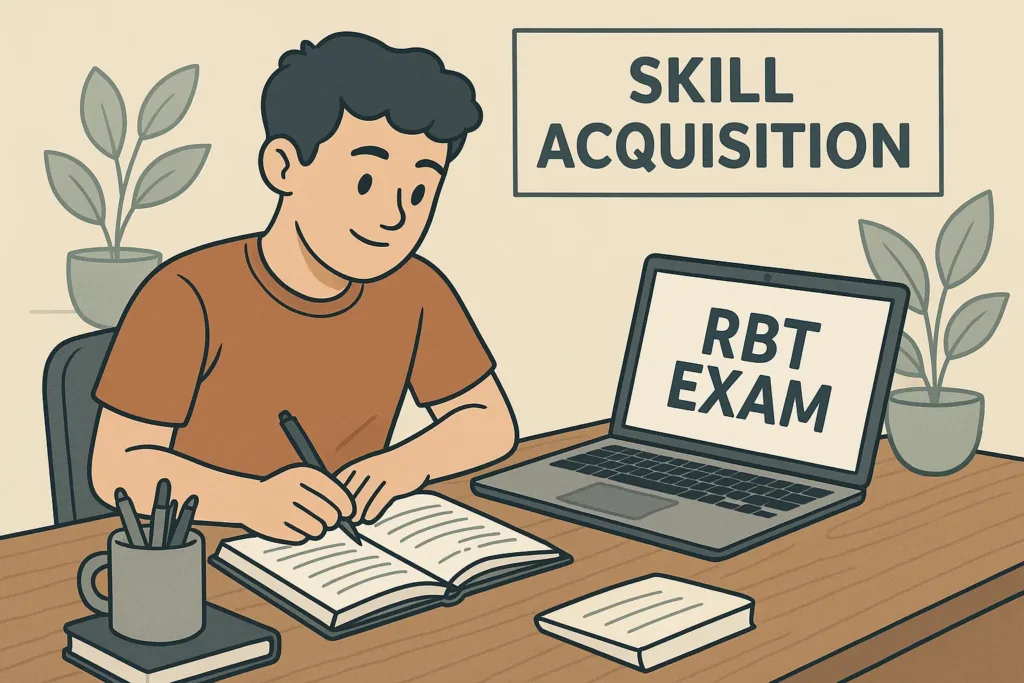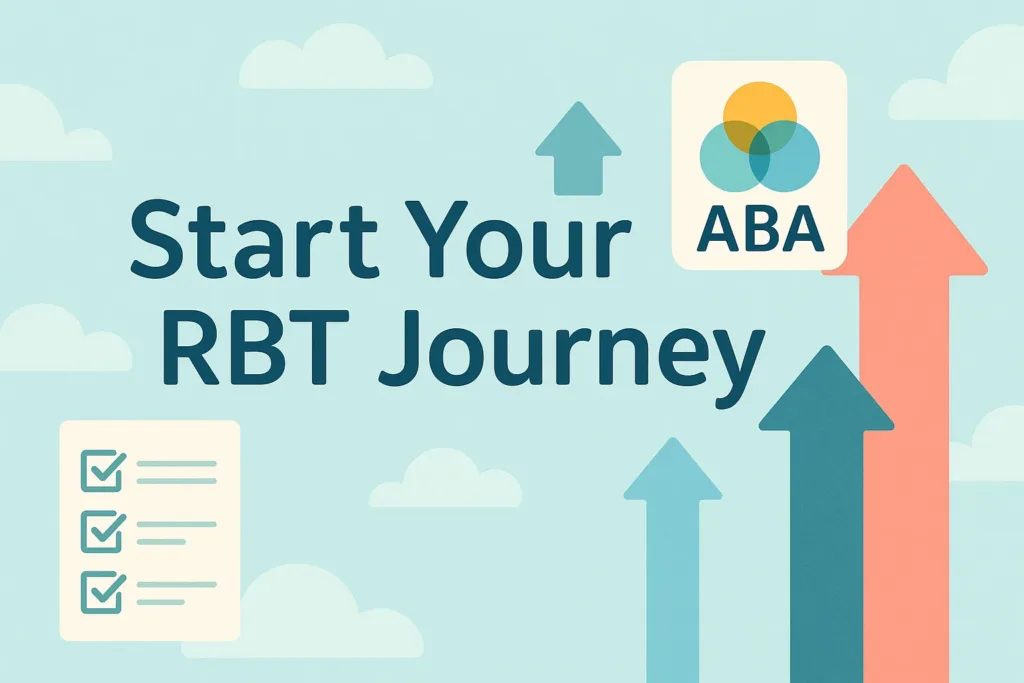RBT Study Guide 2025 – Ultimate FREE Resource to Master the RBT Task List with Confidence

The path to becoming a Registered Behavior Technician (RBT) starts with mastering the knowledge and skills outlined in the official RBT Task List published by the BACB. This RBT Study Guide serves as your central hub for exam preparation, offering a clear and structured overview of the six domains every aspiring RBT must understand. Whether you’re beginning your training or revisiting key areas before your exam, this guide will help you build a strong foundation in essential ABA terminology and practices.
Each domain in the RBT Task List covers a critical area of applied behavior analysis. From measuring behavior to reducing it, and from conducting assessments to maintaining ethical standards, this guide breaks down each sub-task into digestible summaries.
These serve as previews to in-depth domain pages where you can explore the concepts thoroughly as you move forward with your RBT exam preparation.
Ready to test your knowledge? Try our Free RBT Practice Test to apply what you’re learning across all domains.

Use the guide below to structure your Registered Behavior Technician exam preparation step by step.
Table of Contents

A. Measurement
A-1: Prepare for Data Collection
Before working with clients, RBTs must understand what data needs to be collected, how it aligns with the behavior plan, and what materials or tools will be used. Preparation ensures consistent, reliable measurement from the start of each session.
A-2: Implement Continuous Measurement Procedures
This involves recording every instance of a target behavior using methods such as frequency, duration, or latency. These techniques provide precise data about how often and how long behaviors occur.
A-3: Implement Discontinuous Measurement Procedures
Discontinuous methods involve sampling behavior during specific time intervals, such as partial interval, whole interval, and momentary time sampling. These are useful when continuous observation isn’t practical.
A-4: Implement Permanent Product Recording Procedures
Rather than observing behavior directly, this method involves measuring the outcome or result of a behavior, such as completed worksheets or cleaned-up areas.
A-5: Enter Data and Update Graphs
After data is collected, RBTs must accurately input it into tracking systems and update graphs to visually represent progress. This helps supervisors make data-driven decisions.
A-6: Describe Behavior and Environment in Observable and Measurable Terms
Describing behavior clearly and objectively is essential. RBTs must avoid subjective language and instead use specific, measurable terms that anyone can interpret the same way. Accurate measurement depends on clearly defined ABA terminology used consistently throughout your data collection
Learn how to record behavior, define data, and support ABA progress in our Measurement module (A-1 to A-6).
B. Assessment
B-1: Conduct Preference Assessments
Preference assessments help identify what items or activities are most reinforcing for a client. These are essential for increasing motivation during teaching sessions.
B-2: Assist with Individualized Assessment Procedures
RBTs support supervisors during assessments by presenting materials, recording responses, and helping gather baseline data that informs treatment goals.
B-3: Assist with Functional Assessment Procedures
Functional assessments aim to understand the reasons behind problem behaviors. RBTs contribute by collecting antecedent-behavior-consequence (ABC) data and observing behavior patterns.
Explore preference assessments, individualized testing, and functional evaluations in the full Assessment module (B-1 to B-3).

C. Skill Acquisition
C-1: Identify the Essential Components of a Written Skill Acquisition Plan
A solid teaching plan outlines the target skills, instructional procedures, prompts, reinforcement strategies, and data collection methods needed for effective learning.
C-2: Prepare for the Session as Required by the Skill Acquisition Plan
RBTs ensure all necessary materials are ready and the environment is set up appropriately for the session, based on the plan’s specifications.
C-3: Use Contingencies of Reinforcement
Reinforcement increases the likelihood of desired behaviors. RBTs apply both conditioned and unconditioned reinforcers using appropriate schedules.
C-4: Implement Discrete-Trial Teaching Procedures
DTT involves structured instruction using clear cues, specific responses, and immediate consequences to teach skills in small steps.
C-5: Implement Naturalistic Teaching Procedures
Naturalistic approaches embed teaching moments into real-life situations, allowing clients to learn through everyday interactions and choices.
C-6: Implement Task Analyzed Chaining Procedures
Chaining breaks down complex behaviors into smaller steps. RBTs teach these step-by-step, using forward, backward, or total task chaining.
C-7: Implement Discrimination Training
This involves teaching clients to respond differently to different stimuli, helping them make appropriate choices based on environmental cues.
C-8: Implement Stimulus Control Transfer Procedures
RBTs gradually transfer control from prompts to natural cues so that the client can respond independently in the future.
C-9: Implement Prompt and Prompt Fading Procedures
Prompting guides the client toward the correct response, and prompt fading ensures the behavior becomes independent over time.
C-10: Implement Generalization and Maintenance Procedures
Skills should be used across different settings and maintained over time. RBTs support generalization and long-term retention of new behaviors.
C-11: Implement Shaping Procedures
Shaping reinforces successive approximations of a target behavior, allowing clients to learn complex actions in manageable steps.
C-12: Implement Token Economy Procedures
This reinforcement system involves awarding tokens for specific behaviors, which can be exchanged for preferred items or activities.
Master reinforcement, prompting, DTT, and chaining techniques in our complete Skill Acquisition guide (C-1 to C-12).
D. Behavior Reduction
D-1: Identify Essential Components of a Written Behavior Reduction Plan
A behavior reduction plan outlines proactive and reactive strategies to decrease challenging behaviors. RBTs are responsible for following the plan consistently and accurately.
D-2: Describe Common Functions of Behavior
Behaviors usually serve specific functions like gaining attention, escaping tasks, or accessing sensory input. Understanding the function is crucial for selecting effective interventions.
D-3: Implement Interventions Based on Modification of Antecedents
By adjusting environmental triggers or conditions, RBTs help reduce the likelihood of problem behaviors occurring before they start.
D-4: Implement Differential Reinforcement Procedures
Differential reinforcement involves reinforcing a desired alternative behavior while minimizing reinforcement for problem behavior, promoting positive behavior change.
D-5: Implement Extinction Procedures
Extinction involves withholding reinforcement for a previously reinforced behavior. RBTs must apply this carefully to avoid escalation and ensure consistency.
D-6: Implement Crisis/Emergency Procedures According to Protocol
RBTs follow established emergency plans to ensure safety for clients and others during high-risk situations, always in alignment with supervisor instructions.
Learn how to reduce challenging behaviors with ethical ABA strategies in our Behavior Reduction module (D-1 to D-6).
E. Documentation and Reporting
E-1: Effectively Communicate with a Supervisor in an Ongoing Manner
RBTs maintain open lines of communication with supervisors to provide updates, ask questions, and ensure alignment on goals and strategies.
E-2: Actively Seek Clinical Direction from Supervisor in a Timely Manner
When unclear on procedures or encountering new challenges, RBTs are expected to reach out promptly for guidance.
E-3: Report Other Variables That Might Affect the Client in a Timely Manner
External factors like illness, family changes, or medication adjustments can impact behavior. These must be communicated to the supervisor to inform planning.
E-4: Generate Objective Session Notes for Service Verification
Session notes should be clear, specific, and free from opinion. They serve as legal documentation and verification of services provided.
E-5: Comply with Legal, Regulatory, and Workplace Documentation Requirements
RBTs must handle all documentation in accordance with privacy laws, workplace policies, and ethical guidelines to protect client information.
Understand how RBTs document, report, and follow legal compliance in our Documentation & Reporting module (E-1 to E-5).
F. Professional Conduct and Scope of Practice
F-1: Describe the RBT Supervision Requirements and Role in Service Delivery
RBTs work under the supervision of a qualified professional and are responsible for implementing interventions, not designing them.
F-2: Respond Appropriately to Feedback and Improve Performance
Receiving feedback is an expected part of the job. RBTs are expected to respond constructively and make improvements as needed.
F-3: Communicate with Stakeholders as Authorized
RBTs may communicate with parents, caregivers, and other professionals only when authorized by their supervisor and within their role boundaries.
F-4: Maintain Professional Boundaries
Professional relationships must remain appropriate at all times. This includes avoiding dual relationships and maintaining ethical conduct in and out of sessions.
F-5: Maintain Client Dignity
Respect for the client’s autonomy, privacy, and humanity must guide every action. RBTs must promote dignity in every interaction and intervention.
Discover how RBTs maintain ethics, supervision, and client boundaries in our Professional Conduct module (F-1 to F-5).
Final Thoughts on the RBT Study Guide

This RBT Study Guide provides a structured overview of the essential content outlined in the RBT Task List. Each domain you’ve reviewed here is a foundational piece of knowledge that will be tested on the RBT exam and applied daily in practice. For serious RBT exam preparation, be sure to explore the full module pages linked above, where each domain is explained in greater depth with examples and practical applications. For detailed guidelines on certification, supervision, and ethics, refer to the BACB’s RBT Handbook, which complements everything covered in this study guide.
By approaching the material in an organized way and reinforcing your understanding of ABA terminology and techniques, you’ll be prepared not just to pass the exam—but to perform with professionalism and confidence in your role as a Registered Behavior Technician.
Every section is crafted to help you build confidence and competence as a future Registered Behavior Technician. Explore each domain of the RBT Task List in depth by clicking the links in this article, and get ready for your certification exam.
Want to test yourself before moving on? Access our full RBT practice test and section-specific quizzes to reinforce what you’ve studied.
